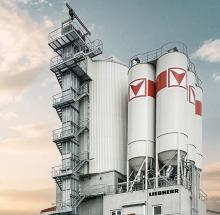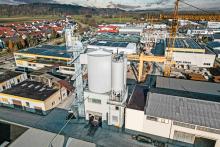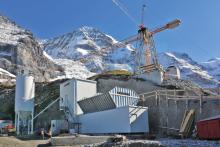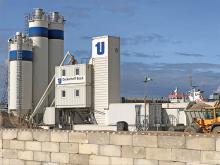
The latest fully automated concrete precasting plants are helping To deliver on site precision. ABE reports on a new facility in Saudi Arabia
Complex architectural designs and challenging structures are calling for ever more precision when it comes to precast concrete. The industry is meeting this demand with the use of state of the art facilities with fullyautomated systems that also help to improve safety.
One of the latest plants to benefit from these new developments is
The new facility is designed around two
According to Liebherr, these mixers are ideal for the mixing of special concretes, especially with mixes for which the addition of colour or additives is required.
For active storage, the mixing plants feature two inline silos for gravel aggregates boasting an overall 600m³ storage capacity. It is possible to store up to six different types of aggregate, with an additional four chambers integrated in the inline silo for special aggregates, each featuring a 10m³ capacity. The skips have been extended to ensure that the inline silos could be installed 5m deeper than usual, allowing loading of wheeled loaders to be undertaken with considerably greater ease.
Four silos, each with 480tonnes storage capacity, have been installed for storage of cement and fill materials. The plant also has additional weighing hoppers to keep the white cement and microsilica separate, so there is no risk of cross-contamination. This is a key advantage for production of lightcoloured elements.
An ice plant and ice weighing system facilitate the production of cooled concrete, a crucial factor wherever high quality concretes are to be achieved in hot countries.
The mixing plants are directly connected with a bucket transport system (two travel tracks), whereby the control systems for bucket transport system and mixing plant intercommunicate with one another. Each of the three ring-pan mixers feature two mixer gates, so there are a total of six positions at which concrete can be collected by the bucket transport system.
A pivoting funnel beneath the mixer platforms can be used in addition to the bucket transport system for the discharge of concrete in truck mixers, allowing added flexibility. The bucket transport system conveys the freshly produced concrete to the individual production lines in the production halls.
Specific requirement indication points are located within the halls, to request the desired concrete type and concrete quantity by the respective personnel.
Despite only being operational for a short time, the Alabniah plant has already successfully delivered hollow cores featuring thicknesses of 150-500 mm, filigree floors, concrete walls in solid or sandwich designs, as well as precast stairway systems. The plant is expected to produce 160,000m3 of concrete products each year.










